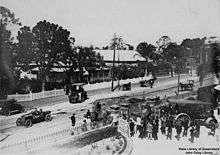Mephisto (tank)

Mephisto is a German A7V tank captured by Australian troops, of the 26th Battalion (composed mainly of Queenslanders), led by two tanks from the Gun Carrier Company. One of only 20 built, it is the last surviving example of the first German tank and at present is displayed at the Australian War Memorial in Canberra, Australia.
Description

Mephisto, chassis serial number 506, is not in running order.
Unlike modern tanks, the A7V has no turret. Instead, it has a cupola for the commander and driver, and its main gun, a 57mm Maxim-Nordenfelt, is carried in a mounting in the front, allowing limited traverse. Six Maxim 08 machine guns are carried in mountings, two on each side and two to the rear.
The name "Mephisto" is painted on the end facing of the box-shaped tank, as almost all German tanks in WW1 were given individual names.
Capture and transport to Australia

The tank was lost at the Second Battle of Villers-Bretonneux on 24 April 1918. The battle for the area saw the Australian, British and German forces in a fluid situation, moving around the tank, which had been abandoned after falling into a ditch.
The 26th Battalion of the 7th Brigade, mostly from Queensland,[1] hatched a plan to capture it. In July 1918, under cover of an artillery barrage, the Australian infantry and two British vehicles (either Gun Carriers or Mark IV tanks) moved forward and dragged it back to their lines; the Germans were still in sight of the tank and firing at them. They had to don gas masks after poison gas was deployed.
The probable 26th Battalion working party involved in the recovery of Mephisto on 22nd July 1918 consisted of Sergeant F.R.Hanson, Privates J.Battley, G Bradley,T.Clark, H.J.Dray, E.J.Frost, A.W.Heit, J.J.Kennedy, T.M.Kingston, R.J.Lewis, A.G.Masters, W.Sam and G.H.White.

Following its capture Mephisto was transported to the 5th Tank Brigade demonstration ground at Vaux-en-Amienois near Amiens. During its stay there it was decorated with "soldier-art" paintings of a British lion with its paw on an A7V, many soldiers' names, details of its capture and recovery, the colour patch of the 26th Battalion and the rising sun badge of the Australian Imperial Force (A.I.F.) The words "TANK BOYS" and the names of 13 soldiers (mainly from other Australian units) were hammered onto the front, left side and rear armour. From Vaux-en-Amienois Mephisto was railed to the Tank Corps Gunnery School at Merlimont and then shipped from Dunkirk to London. Proposals for it to be displayed as a "war trophy" in Australia were raised and on the 2nd April 1919 it was loaded on the SS Armagh at Tilbury. The ship was supposed to deliver it to Sydney, with plans for it to go to the war memorial in Canberra's display, but it was diverted to Brisbane arriving in June, 1919 at the Norman Wharf. Two steam traction engines moved it from the ship to the Queensland Museum, dragging it on its tracks. A7V 504/544 "Schnuck" that had been knocked out by a " friendly/German fire" incident near Fremicourt in August 1918 was captured by elements of the New Zealand Division and taken to Britain as a war prize. "Schnuck" was displayed at Horse Guards Parade 1918/19 and in 1919 was given to the Imperial War Museum. It was scrapped in 1922 but the main gun and its mount were retained and today form part of the Imperial War Museum's collection in London.
Exhibition
The Queensland Museum, where it was housed, changed location a number of times, and the tank at one point was housed outside, where it was exposed to the elements, and parts were removed from it by the public.[2] After many years it was eventually moved inside the museum and put behind glass in a temperature controlled environment that protected it from the public.
Following the 2011 Brisbane Floods, Mephisto was removed from the Queensland Museum to an undisclosed location for restoration work. It was claimed that the vehicle would be returned to the museum during 2012.[3] However, in March 2013 it was revealed that the vehicle was temporarily housed at the Workshops Rail Museum at North Ipswich where it was placed on temporary display.[4] In June 2015, Mephisto was transported to the Australian War Memorial in Canberra.[5][6] It is scheduled to return to the Queensland Museum in 2018.[7]
Replica
A replica A7V modelled substantially upon Mephisto was built in Germany in 1988.
In popular culture
Mephisto is the subject of a fictionalised account of the battle and capture, titled Tank Boys by Stephen Dando-Collins.[8]
In Battlefield 1, Mephisto's unique camouflage is available to players when customising their A7V Tank when in battle.
References
- ↑ Morgan, Joseph (2014). "Voices from Gallipoli and the Western Front: The Forgotten 26th". Sabretache. Garran, Australian Capital Territory: Military Historical Society of Australia. LV (1 (March)): 17–27. ISSN 0048-8933.
- ↑ Connolly, Steve "The great tank Robbery" p. 7, November 2004, The Sunday Mail.
- ↑ Kris Crane (20 January 2012). "Queensland Museum celebrates 150th birthday with a monster bash". The Courier-Mail. Brisbane. Retrieved 25 January 2012.
- ↑ "German WWI tank in Ipswich for forensic analysis" by Kiri Ten Dolle, The Queensland Times, 16 March 2013
- ↑ Queensland Museum [qldmuseum] (15 June 2015). "#Mephisto has arrived in Canberra" (Tweet). Retrieved 15 June 2015 – via Twitter.
- ↑ Morely, Dave (13 August 2015). "The Last of its Kind". Army: The Soldiers' Newspaper (1357 ed.). Canberra: Department of Defence. p. 13. ISSN 0729-5685. Retrieved 12 August 2015.
- ↑ "WW1 tank Mephisto". Conversations with Richard Fidler. ABC. 24 April 2015. Retrieved 26 April 2015.
- ↑ "Tank Boys". Random House Australia. Retrieved 29 July 2015.
External links
| Wikimedia Commons has media related to A7V Mephisto. |
- A7V Mephisto by Greg Czechura and Jeff Hopkins-Weise, ISBN 978-0-9805692-0-9
- "Moving the Mephisto tank to the Queensland Museum, Bowen Hills, Brisbane, 1919"
Coordinates: 27°28′22.77″S 153°01′04.45″E / 27.4729917°S 153.0179028°E